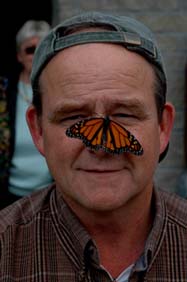Of Fairydiddles, Truffles, and Trees
By William HudsonJohn Muir once said "When we try to pick out anything by itself, we find it hitched to everything else in the Universe." Common sense should have taught us this principle by now, but we still tend to see the earth around us as a collection of individual commodities available to be used or abused at our whim. But in truth, most things in nature are connected in some very complex ways. Take for example fairydiddles, truffles, and trees.

Naturalist William Hudson with a friend
There seems to be some disagreement amongst naturalists and country folk as to whether the name "fairydiddle" should be applied to red squirrels or flying squirrels, but for the purposes of this story, the distinction is not important. Both of these small squirrels have a strong appetite for fungi, especially those that live under the ground, and will risk being eaten by a fox or an owl to dig them up. So why would fairydiddles act so strangely? First, it is important to remember that fairydiddles are entirely dependent on trees, and the subterranean mushrooms that fairydiddles adore, it turns out, are good for the forest.
We now know that well over 85% of all plant species on earth live in harmony with soil fungi. In what are known as mycorrhizal relationships, plant root hairs and fungal threads become intimately connected, allowing fungi to obtain much needed sugars and other products of photosynthesis, and plants to increase the uptake of water and nutrients made more accessible by the fungi. Oaks and other nut-producing forest trees are particularly dependent on mycorrhizal fungi, and most species of forest trees expand into new territories better with fungal partners than without them. Many mycorrhizal fungi with underground fruiting bodies can't distribute their spores on the wind, and depend on the good graces of squirrels and other forest creatures to dig them up, eat them, and then redeposit their pre-fertilized spores in another location.
So the partnership works like this: Mycorrhizal fungi benefit when fairydiddles distribute their spores to new locations, forest trees benefit from the mycorrhizal fungi, and the fairydiddles benefit from more and healthier trees. This simple, elegant relationship is but one of thousands of complex loops of interdependency in nature. Some are known and well understood, and many remain a mystery, but one thing that has become clear since the age of Darwin is that evolution and ecosystems depend at least as much on cooperation and sharing of resources as they do on competition.
Squirrels can be notorious for stripping bark or clipping boughs and fungi growing on roots may appear to be a plague. It may be tempting to control one or both in the name of "improving" the forest. But nature over the eons has developed an amazing and nearly indecipherable web of subtle mechanisms to maximize stability, diversity, and productivity. It seem to me that all of the knowledge that we have accumulated in the category of "natural resource management" pales in comparison to what we don't yet know, or may never completely comprehend. The lesson in fairydiddles, truffles, and trees is that we should be very careful in our clumsy attempts to improve on systems engineered by trial and error over millions of years. Pull on any string and you are tugging at the fabric of the biosphere.
This essay originally appeared in Outlook, a publication of the Buffalo Audubon Society.
